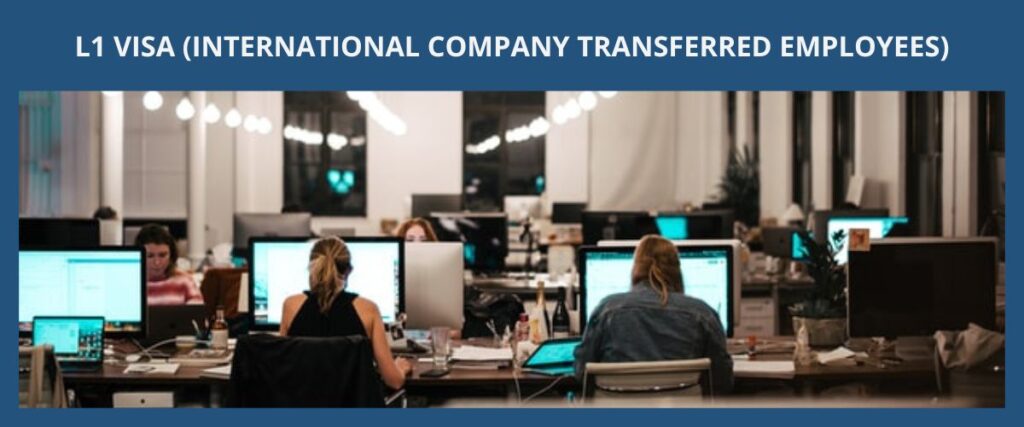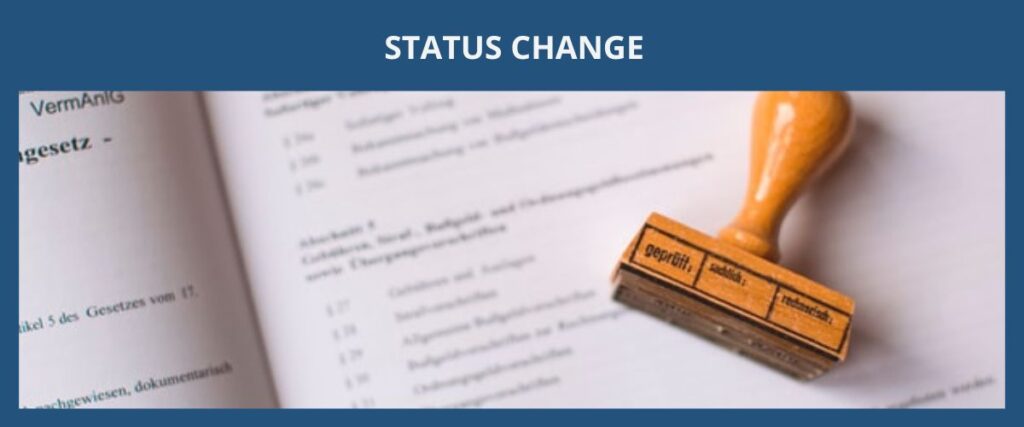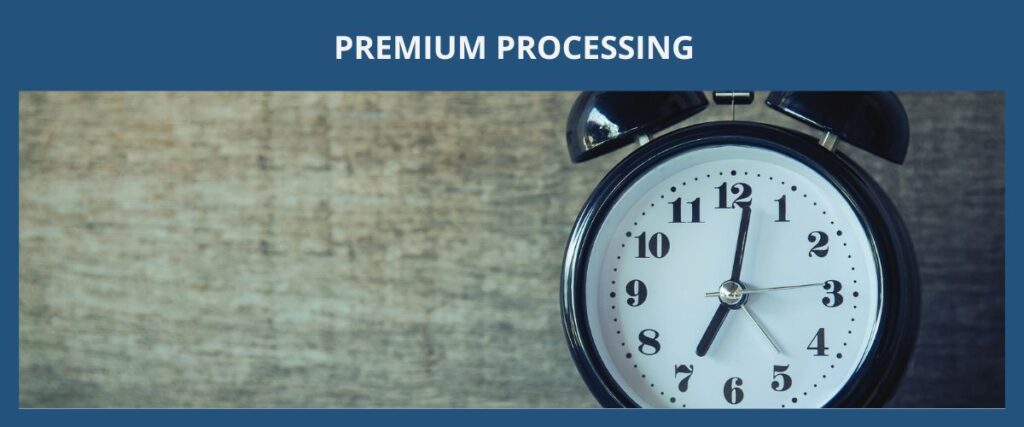The L1 visas are nonimmigrant (temporary) visas for international companies to transfer certain types of employees from an overseas office to work in the U.S. office or send certain employees to start a new office in the United States. The L1 visa workers must have worked full-time continuously at a qualified company overseas for at least 1 year within the 3-year period immediately prior to filing the L1 visa petition.
Table of Contents
There are four sub-categories under the L visa:
- L1A visa: Person who will work in the United States as a manager or executive.
- L1B visa: Person who will work in the United States using their specialized knowledge.
- L2 visa: Family members (spouse and unmarried children under 21 years old) of L1A visa workers and L1B visa workers.
- Special L1 blanket visa (not individual petitions): Person who works for a qualified large multinational organization that frequently files L1 visa petitions.

The L1 visas are for employers to transfer their overseas managers, executives, or professionals with specialized knowledge to work in a U.S. office, or send them to start up a new U.S. office if there is not already one in the United States. The L1A visas are for executives or managers and the L1B visas are for professionals with specialized knowledge. All L1 visa workers are required to have worked continuously with a qualified overseas company for at least 1-year within the 3-year period immediately prior to filing the L1 visa petition.
Special Blanket L1 Visa
Blanket L1 visas are used by large multinational organizations that frequently file for L1 visa petitions. Blanket L1 visa petitions are different from individual L1 visa petitions due to the blanket L1 visa certification serving as proof that the required qualifying intracompany corporate relationship has already been verified for the U.S. sponsoring employer and thus speeding up the processing of adjudicating the L1 visa petitions. In other words, the U.S. sponsoring employer can file a blanket visa petition for its L1 visa workers instead of filing individual visa petitions for each worker which allows for a faster transfer of its managers, executives, and professional employees.
The initial blanket L1 visa certification is valid for 3 years and it will become valid indefinitely after its first extension is approved. If the blanket L1 visa extension is not filed or denied, a second blanket L1 visa certification can only be filed after 3 years.
Eligibility for Blanket L1 Visas
A qualified L1 blanket visa employer must satisfy the requirements listed below:
- (1)
- The employer and its qualifying organizations must be engaged in commercial trade or services
- (2)
- The employer must already have an office in the United States that has been doing business for at least 1 year
- (3)
- The employer must have at least 3 domestic and foreign branches, subsidiaries, and affiliates
- (4)
- The employer and its qualifying organizations must have at least 1 of the following:
- Must have at least 10 approved L1 visas within the past 12 months
- U.S. subsidiaries or affiliates must have a combined annual sale of at least $25 million
- Must have at least 1000 employees in the U.S. workforce
*Nonprofit organizations cannot file for a blanket L1 visa certification.
The blanket L1 visa certification does not include L1 visa workers who are coming to start a new office in the United States or L1B professionals with specialized knowledge that do not have a bachelor’s degree.
L2 Visa Family Members
Dependent family members (spouse and unmarried children under 21 years old) of L1A visa workers and L1B visa workers are allowed to stay in the United States under the L2 visa status. The L2 visa spouse (not the L2 visa child) can legally work in the United States with an employment authorization document (EAD, Form I-765).
The initial L1 visa grants a period of stay for up to 3 years and renewals (extensions of stay) are granted in increments of 2 years up until the maximum limit of 7 years for L1A visas or 5 years for L1B visas are reached. Any time spent physically outside the United States can be recaptured for the maximum limit of 7 years of the L1A visa status or 5 years of the L1B visa status. After the maximum number of years are reached for the L1 visa, the person must be physically overseas (outside the United States) for at least 1 year before filing for a new L1 visa petition. The exception to the 5-year or 7-year limitation is when the person:
- Resides overseas and commutes regularly to the United States for part-time employment
OR
- Did not reside continually in the United States and the employment in the United States was intermittent, seasonal, or was in total six months or less per year
The exceptions cannot be used if the L1 visa worker’s dependent family members resided continuously in the United States under their L2 visa status.
L1 Visa Workers to Start New U.S. Office
For the L1 visa workers who are entering the United States to start a new office, the initial period of stay is up to 1 year and the first renewal (extensions of stay) is granted if the new U.S. office can prove that it is able to employ a manager or executive, or a professional with specialized knowledge of the company.
Blanket L1 Visas
The initial blanket L1 visa certification is valid for 3 years and it will become valid indefinitely after its first extension is approved. If the blanket L1 visa extension is not filed or denied, a second blanket L1 visa certification can only be filed after 3 years.
L Visa Grace Period
The L visa holder is allowed to enter the United States 10 days before the start date and stay an additional 10 days after the end date. However, the L visa holder cannot work in those additional 20 days. There is also a 60-day grace period of authorized stay in the United States if the L1 worker’s employment is terminated before their visa end date.
-eng-1024x427.jpg)
There are 3 main steps in the general process of obtaining an L1 visa:
Step 1: 1-Year Work Experience with Qualified Employer Overseas
The L1 visa worker must have been employed by a qualified employer overseas as a manager or executive, or as a professional with specialized knowledge for at least 1 year immediately prior to filing the L1 visa petition to enter the United States. The U.S. sponsoring employer must have a qualified relationship with the foreign employer that employed the L1 visa worker overseas, and the foreign worker cannot file for an L1 visa petition by themselves (i.e., cannot self-sponsor their own L1 visa petition).
Step 2: Filing the L1 Visa Petition (Form I-129)
The U.S. sponsoring employer files an L visa petition (Form I-129) with the USCIS for the overseas L1 visa worker who is being transferred to a U.S. office or is being sent to the United States to start a new office.
For blanket L1 visa workers, the L1 visa petition (Form I-129S) will typically be adjudicated at the U.S. consulate or embassy during the visa application interview.
*Canadian citizens have an alternative option to apply for their L1 visa directly with the CBP at the port of entry on the U.S.-Canada borders or at a U.S. pre-flight or pre-clearance station located in Canada.
Step 3: Consular Processing or Change of Status
After the L visa petition is approved by the USCIS, the person would need to change into their L visa status which involves either consular processing at the U.S. consulate or embassy overseas (usually in their home country) or a change of status in the United States.
Change of status is usually for a person who is already in the United States with another valid nonimmigrant visa status and has maintained a lawful visa status throughout their time in the United States. On the other hand, consular processing is for a person who lives outside the United States or for a person who is ineligible to change their status in the United States due to noncompliance of U.S. immigration law (e.g., overstayed on their previous visa status, worked when they did not have valid U.S. work authorization, the visa status they used to enter the United States does not allow them to change into another type of visa status, etc.)
Person Outside U.S. (or Person Ineligible for Change of Status)
For a person who is residing overseas (outside the United States) or a person who is ineligible for change of status with the L visa petition (Form I-129), consular processing must be done to obtain the L visa status. Consular processing involves the person attending an in-person interview at the U.S. consulate or embassy usually in the person’s home country. In certain circumstances, a person can do consular processing in another country as a “Third Country National.”
After the interview approval at the U.S. consulate or embassy, the person would have to be admitted entry into the United States by the CBP officer at the border (usually at the airport) which means that the person would have to physically enter the United States as the final step for the L visa status to be activated.
Person Residing in the U.S. (Maintained Lawful Visa Status)
For a person who is already in the United States with another valid nonimmigrant visa, there are usually two options available to obtain the L visa status:
(1) Change of Status: this is the more commonly chosen option where the person states that they would like to change their status without leaving the United States in their L visa petition (Form I-129). If the person is eligible (no violations of U.S. immigration laws), then their nonimmigrant visa status will be changed upon the approved employment start date listed in the L visa petition. In cases where the person’s change of status request is denied or the person needs to change it into consular processing, an application for action on an approved application or petition (Form I-824) may be required.
(2) Consular Processing: this must be chosen if a person cannot show that they have maintained lawful visa status in the United States or for any other reasons such as the person needs to travel internationally before the L visa petition is approved.

The total time an L visa takes is consisted of the processing time for the (1) L visa petition (Form I-129) with the USCIS and the (2) visa application (DS-160) at a U.S. consulate or embassy overseas if the person is not already in the United States or is ineligible to do a change of status within the United States. The L1 blanket visas (Form I-129S) typically are not filed with the USCIS and are processed during the visa application interview appointment at the U.S. consulate or embassy overseas instead.
Factors that influence the L visa petition processing time usually include but are not limited to if there was any Request for Evidence (“RFE”) issued, and the caseload of the USCIS service center and the U.S. consulate or embassy.
Premium Processing for Form I-129 (Expedited Service)
A rough estimate for the Form I-129 petition for the L1 visa is around 6 to 12 months (or 1 month for special blanket L1 visas). However, a 15-day premium processing (Form I-907) is available for the Form I-129 part of the L1 visa petition. Premium processing is an optional expedited service where the USCIS guarantees that the case will be processed within 15 calendar days (not business days). When a notice of intent to deny (NOID) or a request for evidence (RFE) is issued, a new 15 calendar days will start when the USCIS receives a response from the applicant. If the USCIS fails to process within the time frame, a refund of the service fee will be given and the case will continue to be expedited. Please note that USCIS’s guaranteed response may be an approval notice, denial notice, notice of intent to deny (NOID), request for evidence (RFE), or open an investigation for fraud or misrepresentation.
The current premium processing fee for the L1 visa is $2500 USD and it can be requested when the original petition is submitted to the USCIS or an upgrade to premium processing can be done when the case is pending.

Dual intent visas allow the foreign person to have both an intent to temporarily stay in the United States and an intent to permanently stay in the United States. The intention to permanently stay in the United States can be shown when the foreign person has a pending green card petition with the USCIS or an approved labor certification from the U.S. Department of Labor.
The L1 visa is a dual intent visa which means that it is possible for the person to have a green card (permanent residency) petition pending while still being able to maintain and extend (renew) their L1 visa status in the United States. In addition, unlike most nonimmigrant visas, the L1 visa worker is not required to maintain a residence (home address) overseas.
The L1 visas are for companies to transfer managers (L1A visa), executives (L1A visa), or professionals with specialized knowledge (L1B visa) from their overseas offices to a U.S. office or to send them to the United States to start a new office. The L1 visa workers must have worked full-time continuously at a qualified company overseas for at least 1 year within the 3-year period immediately prior to filing the L1 visa petition.
If you have an L1 work visa (Managers, Executives, or Specialized Knowledge Professionals for Multinational Companies) immigration question, please fill out our contact us form or send us an email with some basic information about your background and your immigration needs. We will do our best to respond within 48 hours.
How we can help?
Kylie Huang Law’s immigration attorney will help identify whether the L1 visa is the appropriate nonimmigrant visa category for the client’s (or the client’s beneficiary’s) professional background and if there are other visa options for the client (or the client’s beneficiary). We will work closely with our client to prepare a convincing case for their (or it’s) L1 visa petition and we will also strategize on how the L1 visa petition should be presented to achieve the best chances of approval. It is strongly advised and common practice to retain an immigration attorney for an L1 work visa petition due to the complexities in the immigration process and visa requirements.
What does the typical process look like to retain (hire) us?
- Step 1:
- Step 2:
- Step 3:
- Step 4:
- Step 5:
- a.
- b.
- c.
- Step 6:
- Step 7:
- Step 8:
- Fill out the form (with some basic information on what your immigration needs are)
- Sign up and log into the client portal to schedule an appointment online
- Attend scheduled appointment (typically a phone call or zoom meeting)
- Retainment (signing a contract to hire us)
- Start processing case
- Gathering required documents
- Preparing paperwork
- Confirming contents of documents that will be submitted
- Filing the case
- Following up on the status of the case
- Close the case when a final determination is issued
- Step 1:
- Step 2:
- Step 3:
- Step 4:
- Step 5:
- a.
- b.
- c.
- Step 6:
- Step 7:
- Step 8:
- Fill out the form (on what your immigration needs are)
- Sign up and log into the client portal to schedule an appointment
- Attend scheduled appointment (typically a phone call or zoom)
- Retainment (signing a contract to hire us)
- Start processing case
- Gathering required documents
- Preparing paperwork
- Confirming contents of documents that will be submitted
- Filing the case
- Following up on the status of the case
- Close the case when a final determination is issued
- Step 1:
- Step 2:
- Step 3:
- Step 4:
- Step 5:
- a.
- b.
- c.
- Step 6:
- Step 7:
- Step 8:
- Fill out the form (on what your immigration needs are)
- Sign up and log into the client portal to schedule appointment
- Attend scheduled appointment (typically a phone call or zoom)
- Retainment (hire us)
- Start processing case
- Gathering required documents
- Preparing paperwork
- Confirming content of documents that will be submitted
- Filing the case
- Following up on the case status
- Close the case when a final determination is issued
RELATED ARTICLES
- L1A Visa (Manager / Executive Transferee)
- L1A Visa Requirement & Documents
- L1A Visa Checklist (Manager / Executive Transferee)
- L1B Visa (Specialized Knowledge Transferee)
- L1B Visa Requirement & Documents
- L1B Visa Checklist (Specialized Knowledge)
- H Visa Overview (Specialty Occupations)
- H1B Visa (Specialty Occupations)

